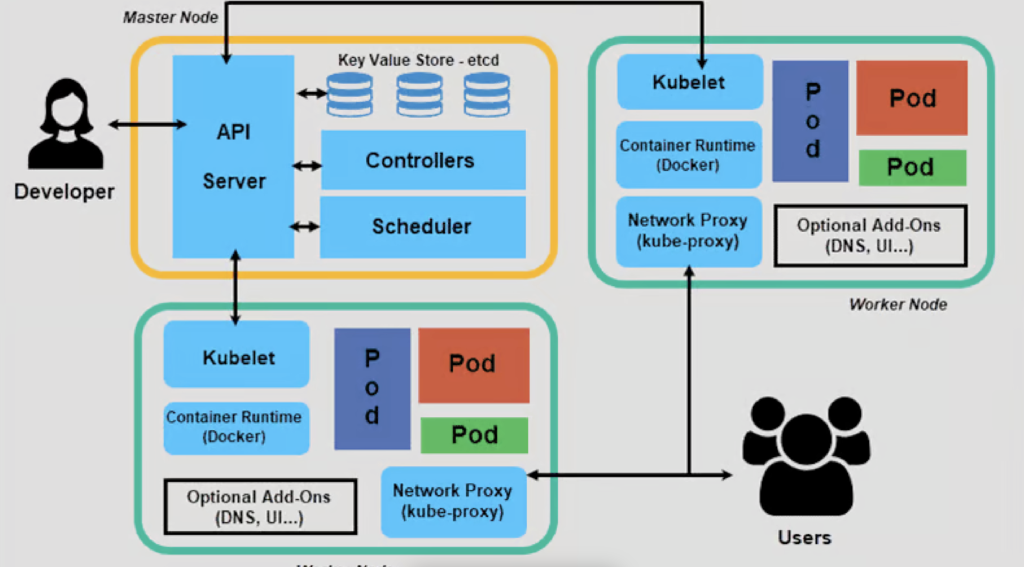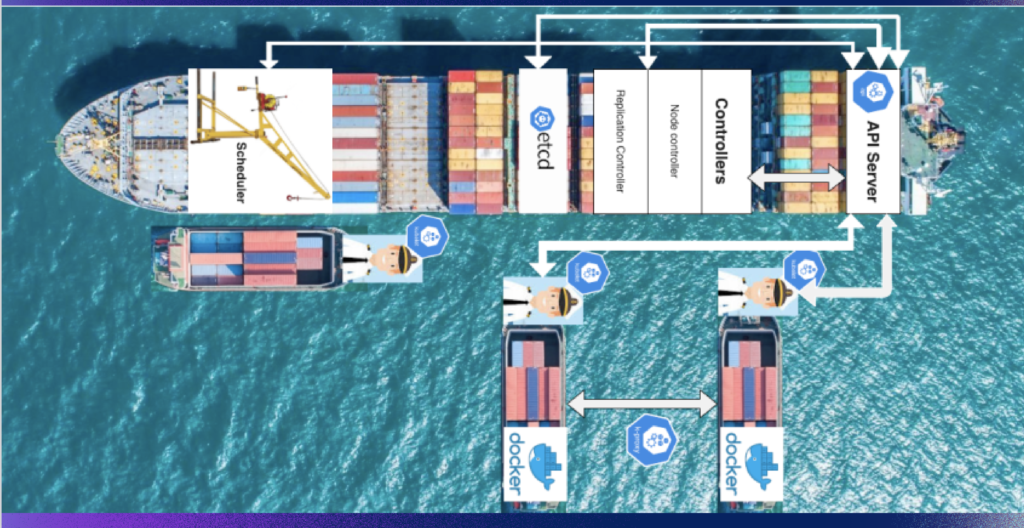Kubernetes Cluster Architecture Made Simple
 Sandeep Naidu
Sandeep NaiduWhat is Kubernetes?
Kubernetes (often shortened to K8s) is like the manager of a shipping port, but instead of cargo ships and containers, it manages apps and software containers. It's a powerful tool that automates how applications are launched, managed, scaled, and fixed when things go wrong — whether you’re using cloud servers, your own hardware, or both.
The Building Blocks of Kubernetes
Let’s break it down using a shipping and port analogy, so it’s easier to understand:
1. Master Node (Control Plane) – The Brain of the Cluster
This is the main control room of the Kubernetes system. It makes all important decisions like:
Where to run apps
When to start or stop them
How to handle issues
Think of it as the captain’s bridge on a cargo ship.
2. Worker Nodes – The Employees Doing the Work
These are the machines (servers) where your applications actually run. If the master node is the captain, these are the ships carrying containers. Each worker node can run many applications, grouped inside small units called pods.
3. Kube Scheduler – The Container Loader
This tool decides which worker node should run a new application. It checks things like available memory, CPU power, and other requirements. It’s like a harbor worker assigning which ship will carry which container.
4. ETCD – The Log Book
ETCD is like the record book of the entire system. It stores all configuration settings and current status. It’s like a ship’s manifest that tracks what’s happening at all times.
5. Controller Manager – The Operations Team
This constantly checks if everything is working as expected. If something breaks or changes, it takes action to fix it and match the planned setup. Imagine it as the fleet operations office keeping everything on schedule and in sync.
6. API Server – The Reception Desk
This is the entry point for anything trying to communicate with Kubernetes – users, tools, or even other programs. It checks, processes, and passes the requests to the right place. It’s like a control tower or helpdesk managing all incoming instructions.
7. Kubelet & Kube Proxy – Onboard Helpers
Kubelet: Makes sure the app containers on each worker node are running smoothly.
Kube Proxy: Handles the network traffic, making sure apps can talk to each other.
These are like onboard engineers and communication officers on each ship.
8. Container Runtime – The Engine
This is the actual engine that runs the applications inside containers. Docker is one of the most common ones used. Just like an engine powers a ship, the container runtime powers the software.
Kubernetes:
Kubernetes is a free and open tool that helps companies automate how their software runs. It takes care of things like launching apps, scaling them up or down, and fixing issues automatically, especially when you're using containers (small, packaged versions of apps).
It was first created by Google and is now managed by the Cloud Native Computing Foundation (CNCF). Today, it's the most widely used tool for managing container-based applications.
Think of Kubernetes like a music conductor it coordinates many different parts (your apps) across many machines, making sure everything runs smoothly. It handles complicated tasks like:
Balancing the load across servers
Managing storage
Rolling out updates
Fixing things when they go wrong
Kubernetes works no matter where your apps are running — in the cloud, on your company servers, or both (a hybrid setup). It helps teams manage their software more efficiently by providing tools to automate and control everything.
Because of its strong community and wide use, Kubernetes has become the backbone of modern software systems, used for everything from simple websites to large, complex applications.

Kubernetes Ship Analogy – A Visual Explanation
Imagine a giant shipping port:
The control tower (master node) oversees all activities.
Dockworkers (scheduler, controllers) assign tasks and keep everything running.
The ships (worker nodes) carry multiple containers (your applications).
All are connected by communication lines (network).
There’s a logbook (ETCD) that tracks everything.
Kubernetes ensures the containers (apps) are:
Placed in the right ships
Connected properly
Balanced across ships
Updated automatically
Recovered quickly if something fails
This analogy shows how Kubernetes orchestrates complex systems the same way a port handles the movement of thousands of containers.

In Summary (For Non-Tech Folks)
Kubernetes is like a smart shipping manager for applications.
It makes sure your apps are running, connected, updated, and fixed automatically.
It’s used by companies to manage modern software efficiently – whether on cloud or in-house.
Subscribe to my newsletter
Read articles from Sandeep Naidu directly inside your inbox. Subscribe to the newsletter, and don't miss out.
Written by

Sandeep Naidu
Sandeep Naidu
Cloud & DevOps Engineer| SRE | Kubernetes | AWS | Ansible | GIT | Terraform | Gitlab | Docker | Python